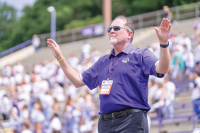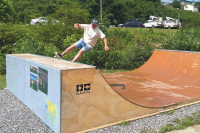This must be the place
 Claire Lynch likes to blur lines.
Claire Lynch likes to blur lines.
Born and raised in Upstate New York, she eventually moved away, crossing the Mason-Dixon Line for Alabama at age 12. She carried in her mind the sounds of the 1960s folk scene of Greenwich Village in Manhattan and show tunes echoing from the record player in her childhood home. Soon, she’d cross paths down South with country and bluegrass melodies radiating from Nashville and beyond.
She was a musical sponge, blurring the lines between interstates, influence and intent.
As a teenager, she began searching for new music, people and places. She eventually found herself at a bluegrass festival in Huntsville, Ala., in 1973. It was there she laid her eyes on the power of string music, and also her future husband, who opened the show. The couple began collaborating together, with Lynch coming into her own. Her words found themselves on recordings by Kathy Mattea and Patty Loveless, while her voice backed greats like Dolly Parton, Linda Ronstadt and Emmylou Harris.
Now 60, Lynch has garnered quite a successful career as a leading lady in bluegrass. She is a three-time International Bluegrass Music Association Female Vocalist of the Year winner (1997, 2010 and 2013) and was also nominated in 2013 for the IBMA Album of the Year with her release “Dear Sister.”
Related Items
Lynch will be performing at the Cataloochee Guest Ranch in Maggie Valley on Oct. 5.
The Smoky Mountain News recently caught up with Lynch as she prepared to head out for the 2014 IBMA award show in Raleigh this week. She spoke of what is was like early on being one of the few female lead singers in a bluegrass band, how the first time she heard a banjo changed her life, and why blurring lines in her life and music gives her the ultimate advantage in the entertainment industry — perspective.
Smoky Mountain News: You grew up in New York in the 1960s. What were your early musical influences?
Claire Lynch: There was a lot of music around me. As a child, most of it was church music and show tunes on records, folk music was big at the time.
SMN: And with that, with you moving down South, too, your music blurs the lines between folk, bluegrass and country.
CL: I think my whole life is a blurred line. I come from New York, so I think there was that sensibility, my older sister moved out of the house to Greenwich Village in New York City — that had a big impression on me. It was a whole different dynamic of education for me, between being in New York and Alabama. I think it’s worked to my advantage because I think it has brought a broader sensibility to my music.
SMN: What was your first exposure to bluegrass music?
CL: I never saw a bluegrass band live until I was 19. I was exposed to a form of country music that included banjos and fiddles — opera shows out of Nashville, The Porter Wagoner Show, “Hee-Haw” with Roy Clark playing banjo. It was a bluegrass festival in 1973 at the University of Alabama at Huntsville where I first saw bluegrass. It was dynamic, and there was something that came off of those people energy-wise. I really hadn’t heard that kind of banjo played in my face before — it was a very complete sound, with no amplification. It was very overwhelming and I had to sit down. It’s a very pure sound.
SMN: So, where was your launch pad for bluegrass music then?
CL: It was right then and there, at that festival. There were two bands that day, The McLain Family Band and this other opening band. I went into the concert and there were a couple of dudes I knew from high school playing in the opening band (Hickory Wind), and I went up to them to say hello and from there I rekindled an old friendship with one of the players Larry Lynch, who I ended up marrying and playing with for 25 years.
SMN: When you got started in bluegrass in the early 1970s, there weren’t a lot of females fronting bands.
CL: I didn’t give it any thought really. I was used to the male dominance in the scene and it was no skin off of my back. I knew a lot of women who entered the bluegrass world when I did that were offended, but I didn’t feel that way. I think the audience thought we were a breath of fresh air because I was a girl. There were definitely people behind our backs who said we weren’t part of bluegrass, but I didn’t get any of that from people in our scene and those at the festivals.
SMN: Why is it important that bluegrass music be perpetuated and remain vibrant in a modern world?
CL: Because it’s real, don’t you think? There’s a lot of plastic stuff out there today. Pop music, a lot of it lately, is cookie-cutter and enhanced in so many ways, graphically and audibly. Universally, we all have desires and those things can be communicated in a primitive way though music. I think people want to be grounded or closer to the earth — bluegrass music makes that connection.
Want to go?
Acclaimed bluegrass singer Claire Lynch will perform at 7:30 p.m. Sunday, Oct. 5, at the Cataloochee Guest Ranch in Maggie Valley. Dinner will be served at 6 p.m. Tickets, which include dinner and the performance, are $60. Reservations are required. 828.926.1401 or www.cataloocheeranch.com.
Hot picks
1 Old-time/swing singer Russ Wilson will perform at 7 p.m. Oct. 11 at The Classic Wineseller in Waynesville.
2 ColorFest: Dillsboro Fine Arts & Crafts Fair will be held from 10 a.m. to 4 p.m. Oct. 4 in downtown.
3 Newgrass band Mangas Colorado will perform at 8 p.m. Oct. 3 at Nantahala Brewing in Bryson City.
4 Maggie Valley Oktoberfest will be held from 10 a.m. to 11 p.m. Oct. 3-4 at the festival grounds.
5 Christian rock singer and American Idol contestant Colton Dixon will perform at 6 p.m. Oct. 12 at Haywood Community College in Clyde.









